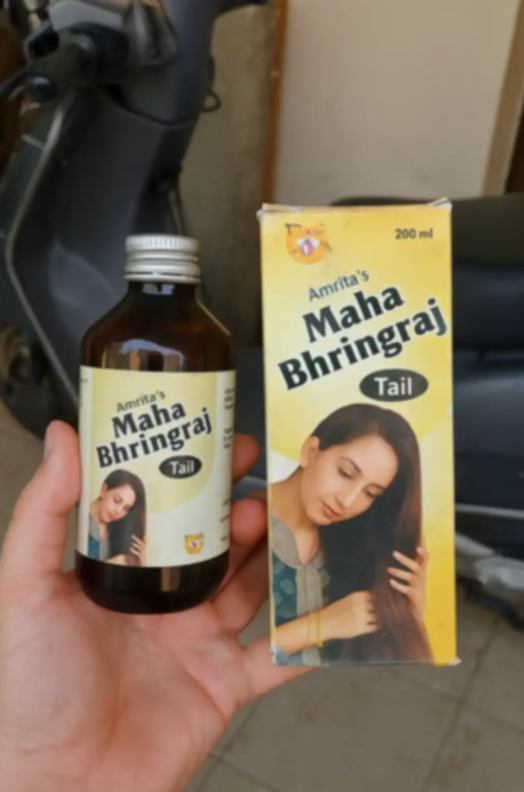Key Benefits of Amrita Maha Bhringraj Tail
- Helps prevent premature greying and split ends
- Reduces hair fall by strengthening roots & follicles
- Deeply nourishes scalp, soothing itch and flaky dandruff
- Restores natural hair shine for a lustrous look
- Promotes healthy hair growth over time
- Improves hair texture, making strands soft & manageable
- Balances scalp health, for overall hair vitality
Product Description of Amrita Maha Bhringraj Tail
Amrita Maha Bhringraj Tail is a traditional Ayurvedic hair oil crafted to bring your hair back to life with time-tested herbs. Infused with pure coconut oil processed alongside freshly extracted Bhringraj juice and a paste (kalka) of Manjishtha, Padmakashtha, Lodhra, Rakta Chandan and more, this oil carries a rich aroma and a nurturing touch. I sometimes forget my nightly ritual but when I do indulge, my scalp feels calmer the very next morning, less dry and irritated. It has that faint golden hue (thanks to Haridra and Daruharidra) that hints of healing. Great for people dealing with dandruff, thinning hair, premature greying or just wanting that extra shine. It’s easy: massage into scalp, let it rest—overnight or a few hours—and wash off to see improved texture, strength and lustre. A small bottle but a powerful blend, truly.
Key Ingredients with Descriptions of Amrita Maha Bhringraj Tail
- Narikela Taila (Coconut oil): Traditional carrier oil used in Ayurveda for scalp lubrication and nourishment.
- Bhringaraj (Eclipta alba Hassk.) juice: Revered herb for hair health and promoting hair growth.
- Manjishtha (Rubia cordifolia L.) kalka: Known for its natural pigmentation support and blood-purifying properties.
- Padmakashtha: Ayurvedic herb paste traditionally used to cool and soothe the scalp.
- Lodhra (Symplocos racemosa Roxb.): Herb that helps maintain hair texture and scalp balance.
- Rakta Chandan: Red sandalwood, valued for its cooling and soothing effect on skin and scalp.
- Swarna Gairikam Shuddha: Purified rock salt prepared following classical Ayurvedic methods.
- Kantakari (Solanum xanthocarpum Schrad. & H.Wendl.): Herb known to support healthy scalp conditions.
- Haridra (Curcuma longa L.): Turmeric, lauded for its natural antiseptic and anti-inflammatory qualities.
- Daruharidra (Berberis aristata DC.): Berberis root used traditionally for its purifying action.
- Nagakesara (Mesua ferrea L.): Flower extract used in Ayurvedic formulas for shine and conditioning.
- Priyangu: Herb paste often used to nourish hair follicles and roots.
- Yashtimadhu (Glycyrrhiza glabra): Licorice root, known to soothe and reduce scalp irritation.
- Kamala Pushpa: Lotus flower known in Ayurveda for its cooling and reparative properties.
- Sariva (Hemidesmus indicus (L.) R.Br.): Indian sarsaparilla used traditionally for scalp cleansing.
Key Uses of Amrita Maha Bhringraj Tail
- Nightly or weekly scalp massage to strengthen hair roots and improve circulation.
- Pre-shampoo treatment: apply 1–2 hours before washing for deep conditioning.
- Leave-on hair mask: keep overnight to reduce dryness, flakiness and split ends.
- Post-chemotherapy care: consult a physician, may help soothe sensitive scalp.
- Use as a herbal hot oil treatment: gently warm oil and apply to scalp for added relaxation.
- Blended into hair packs: mix with yogurt or henna for an added boost (if you like experimenting!).
How to Use Amrita Maha Bhringraj Tail
Warm 10–15 ml of oil slightly. Part your hair, apply to roots and scalp. Massage in circular motions for 5–10 min. Leave on overnight or at least 2 hours. Shampoo gently next morning. Repeat 2–3 times a week for best results. Make sure to do a small patch test before full use
Safety Information about Amrita Maha Bhringraj Tail
- Children: Not recommended for kids under 2 years; always perform a patch test.
- Pregnant Women: Consult your healthcare provider before use, especially in first trimester.
- Breastfeeding Mothers: Safe in moderation but do a patch check to rule out sensitivity.
- People with Chronic Diseases: Seek medical advice if you have scalp dermatitis or related conditions.
- People with Allergies: Contains herbal extracts; avoid if allergic to any listed botanicals.
- Elderly Individuals: Generally safe, but patch test for delicate skin recommended.
- Patients Taking Medications: No known interactions topically, but ask your pharmacist if concerned.
- People with Weakened Immunity: Use under guidance if you have active infections or open wounds.
Additional Information about Amrita Maha Bhringraj Tail
Packaged in a dark amber glass bottle to guard against light and preserve potency. Store in a cool, dry place away from direct sun. Shelf life: 24 months from manufacturing date. Made in small batches, maintain batch code for traceability. Availabe in 200 ml size. Please recycle or reuse the bottle once you’ve finished. Slight natural sedimentation may occur – it’s normal, just shake gently before use!
